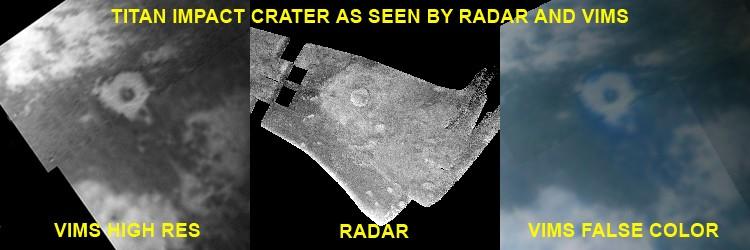Titan Crater in Three Views

| PIA Number | PIA07868 |
|---|---|
| Language |
|
This three-panel image shows one of Titan's most prominent impact craters in an
infrared-wavelength image (left), radar image (center) and in the false-color image (right).
The Cassini radar imaged this crater during Cassini's third flyby of Titan, on Feb. 15,
2005, (see Impact Crater with Ejecta Blanket). The crater, located at 16 degrees west, 11 degrees north, is about
80 kilometers (50 miles) in diameter and is surrounded beyond that by a blanket of
material thrown out of the crater during impact. In radar, brighter surfaces mean rougher
terrains, or else terrains tilted toward the radar.
Two Titan flybys later, on April 16, the visual infrared mapping spectrometer on Cassini
obtained images of the same crater. The panel on the left is an image at the 2.0 micron
wavelength, showing that the crater has a dark floor and a small bright area in the center.
The crater is surrounded by bright material, which has a very faint halo slightly darker
than the surrounding dark material. Compare the radar image with the visual infrared
mapping spectrometer image. Both the crater and the blanket of surrounding material
(called ejecta) are bright at radar wavelengths; in the infrared, the crater itself is dark and
this blanket of material is quite bright. In radar, the faint halo surrounding the blanket of
material is quite similar in appearance to the rest of the ejecta blanket.
The right hand panel is a false-color visual infrared mapping spectrometer image of the
crater at lower resolution. It shows the faint halo to be slightly bluer than surrounding
material. That the material is bluer than its surroundings, while also being darker, suggests
that the faint halo is somewhat different in composition. This suggests that the
composition of Titan's upper crust varies with depth, and various materials were
excavated when the crater was formed.
The same structure appearing so different to different instruments illustrates the
importance of multiple instruments studying such phenomena. The Cassini spacecraft,
being the most interdisciplinary spacecraft ever flown, strongly embodies such an
approach.
The Cassini-Huygens mission is a cooperative project of NASA, the European Space
Agency and the Italian Space Agency. The Jet Propulsion Laboratory, a division of the
California Institute of Technology in Pasadena, manages the mission for NASA's Science
Mission Directorate, Washington, D.C. The Cassini orbiter and its two onboard cameras
were designed, developed and assembled at JPL. The radar instrument team is based at
JPL, working with team members from the United States and several European countries.
The visual and infrared mapping spectrometer team is based at the University of Arizona,
Tucson.
For more information about the Cassini-Huygens mission visit http://saturn.jpl.nasa.gov .
For more information about the visual and infrared mapping spectrometer visit http://wwwvims.lpl.arizona.edu.
Credit: NASA/JPL/University of Arizona
